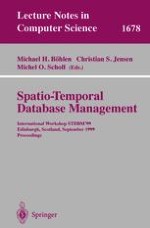1999 | OriginalPaper | Buchkapitel
Evaluation of Access Structures for Discretely Moving Points
verfasst von : Mario A. Nascimento, Jefferson R. O. Silva, Yannis Theodoridis
Erschienen in: Spatio-Temporal Database Management
Verlag: Springer Berlin Heidelberg
Enthalten in: Professional Book Archive
Aktivieren Sie unsere intelligente Suche, um passende Fachinhalte oder Patente zu finden.
Wählen Sie Textabschnitte aus um mit Künstlicher Intelligenz passenden Patente zu finden. powered by
Markieren Sie Textabschnitte, um KI-gestützt weitere passende Inhalte zu finden. powered by
Several applications require management of data which is spatially dynamic, e.g., tracking of battle ships or moving cells in a blood sample. The capability of handling the temporal aspect, i.e., the history of such type of data, is also important. This paper presents and evaluates three temporal extensions of the R-tree, the 3D R-tree, the 2+3 R-tree and the HR-tree, which are capable of indexing spatiotemporal data. Our experiments focus on discretely moving points (i.e., points standing at a specific location for a time period and then moving “instantaneously”, and so on and so forth). We explore several parameters, e.g., initial spatial distribution, spatial query area and temporal query length. We found out that the HR-tree usually outperforms the other candidates, in terms of query processing cost, specially when querying time points and small time intervals. However, the main side effect of the HR-tree is its storage requirement, which is much larger than that of the other approaches. To reduce that, we explore a batch oriented updating approach, at the cost of some overhead during query processing time. To our knowledge, this study constitutes the first extensive, though not exhaustive, experimental comparison of access structures for spatiotemporal data.
